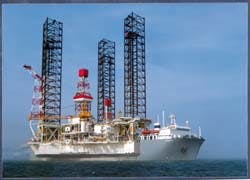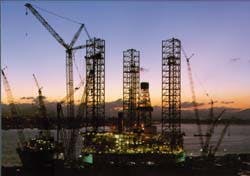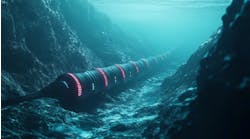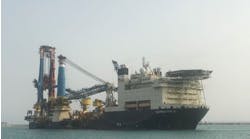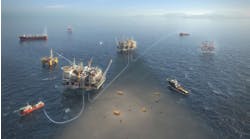PRODUCTION TGP500 Harding platform successful accommodation with CRINE and a milestone in partnering
World's largest jackup platform installed on the North Sea Harding Field
Dev George
Manageing Editor - International
The Harding Platform aboard the Transhelf enroute to its North Sea site.
Sometimes great ideas are so simple they escape capture until someone almost stumbles over them. Such is the case of the remarkable Harding Field platform, set for installation on its UK North Sea site this month. The structure incorporates the efficiency of operation and ease of installation of a jackup, the practicality of a seafloor storage tank/gravity base, and the safety and simplicity of a submerged turret loading system. The combination production, drilling, and quarters facility was conceived by Technip-Geoproduction (TGP) as a flexible, cost-effective satellite drilling and production platform. In fact, it is projected to produce oil at just $3.50 a barrel.
TPG500 system
Technip-Geoproduction originated the TPG 500 as a pre-designed mobile minimum facility tailored for adaptation to the smaller North Sea fields, yet able to handle production of up to 100,000 b/d oil while complying with CRINE standards. British Petroleum saw this design as a means of transforming their previously marginal Forth Field - now renamed Harding Field for the late David Harding, BP Exploration (Europe)'s chief executive responsible for the North Sea - into a commercial prospect. Thus it became the centerpiece of the BP Harding Project.
The Harding Field was discovered in 1988 by Britoil, now wholly owned by BP Exploration. An Eocene reservoir, it lies in UKCS license Block 9/23b in the northern North Sea, about 190 km north of Forties and 35 km south of Beryl. The partners are BP (70%), Repsol (25%) and Ranger (5%).
Reserves of 185 million bbl of oil and 200 bcf of gas in the Central and South accumulations have been confirmed, but additional reserves are known to be present in the North, Northeast, Southeast, and Deep South pools. Once the core accumulations in the Central and South pools begin to decline, those of the North and Northeast may be developed, but the Southeast and Deep South pools are stratigraphically deeper and more complex and will require additional technology if they are ever developed.
The TPG500 is being sited between the core Central and South reservoir accumulations. Horizontal drilling will provide the necessary step-out to the wells and their completion within the shallow depth of the reservoirs. Although the platform is designed for 20 well conductors and 24 slots arranged in a six by four array, just 16 wells will be drilled, passing through guides on the gravity base tank (GBT). Eight of them will be production wells, five water injectors, one a gas cap well, and two will be aquifer wells to provide the water to that is programmed to be injected.
The Harding Platform is designed to handle processing and export of 64,000 b/d of crude oil, and has the capacity to handle up to 146,000 b/d of gross reservoir fluids through its separation train. Associated gas will power the platform's gas turbine generators, with excess gas being reinjected.
The produced oil will be exported by offshore tanker loading, but it will be stored in the massive concrete gravity base tank on the seafloor to which the platform is fixed to await the weekly dedicated tankers.
The 85,000-ton GBT was designed and built by Scottish contractor Costain-Tailor Woodrow at its yard in Hunterston, then towed to the Harding Field site for installation. It acts not only as the foundation for the Harding Platform, but as a drilling template and 500,000-bbl storage facility for Harding's produced oil.
A T-shaped, prestressed concrete structure, the GBT is 115 meters long, 120 meters wide, and 34 meters tall, and composed of 80 interconnecting cells some 19 meters deep. It was installed in July at a depth of 109 meters.
Hyundai Heavy Industries
Skidding the platform onto the Transhelf the night before its departure.
A modified version of the TPG500, BP's Harding Field platform was built at the world's largest marine construction yard, Hyundai Heavy Industries' Ulsan, South Korea facility, in only 19 months. The structure was then towed for 54 days before reaching its permanent North Sea location.
Hyundai Heavy Industries was chosen for the design completion, fabrication, assembly, commissioning, load-out, and sea-fastening of the platform on the basis of 20 years offshore fabrication experience with about 60 such projects.
From project sanction to sailaway, Hyundai's fast-track development of this, the largest and first self-installing jackup platform composed of production, drilling, and living quarters ever built to be used as a permanent offshore facility, was a study in teamwork and coordination, an exemplary example of the spirit partnering.
The integrated unit comprises the basic hull unit, topside production facilities, and drilling facilities to process and export the oil daily. The basic hull unit is a triangular-shaped vessel with three levels, which measures 102 meters wide, 88 meters long, and nine meters high. The legs with a flat spud footing, are located at each corner of the hull. Total weight is just over 24,000 tons.
The partnering role played by the contractors was a unique characteristic of the BP Harding project. Not only did a tight and close relationship develop between BP and Hyundai, but Hyundai was able to develop good cooperation between itself and the other major contractors, thereby saving costs and shortening the project schedule.
Team spirit was a big part of the project's success. Every two to three months, all the major contractors met to facilitate coordination, to accelerate the project, customize it, and improve cost efficiency. The BP project team included not only Hyundai, which sent ten of its engineers to London to work on problem-solving, but the GBT's designer-builder Costain-Tailor Woodrow, the TPG/McDer-mott consortium, which first demonstrated the viability of the TPG500 design and was responsible for the basic process and topsides; Anson supplied the choke and kill manifold package for the drilling module; Cegelec Projects provided the switchboards and associated equipment; Global Corrosion cathodic protection equipment; Jordan Kent the oil metering system; Rowco International total logistics management; Smedvig detail engineering and drilling operations; Statoil the production loading and transport system for the oil, based on Statoil's new submerged turret loading system (which ensures that tankers loading Harding oil will be able to operate in wave heights up to 10 meters); Subsea Offshore is to provide all underwater services; and Trafalgar House Offshore Services will provide operation and maintenance support.
Dockwise transported the Harding Platform from Hyundai's South Korea yard to its North Sea site aboard the semisubmersible heavy lift vessel Transshelf.
The Harding Platform required minimal hook up work due to its unique design. Two wells will be drilled right away to put the field into early production before the end of this year.
Copyright 1995 Offshore. All Rights Reserved.

